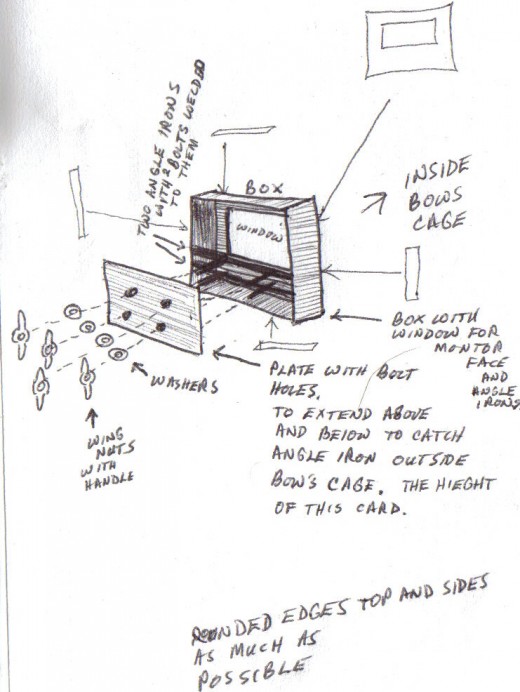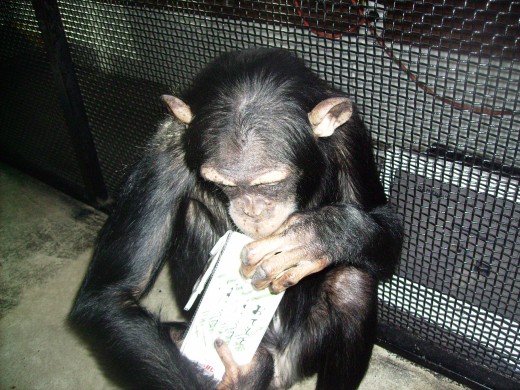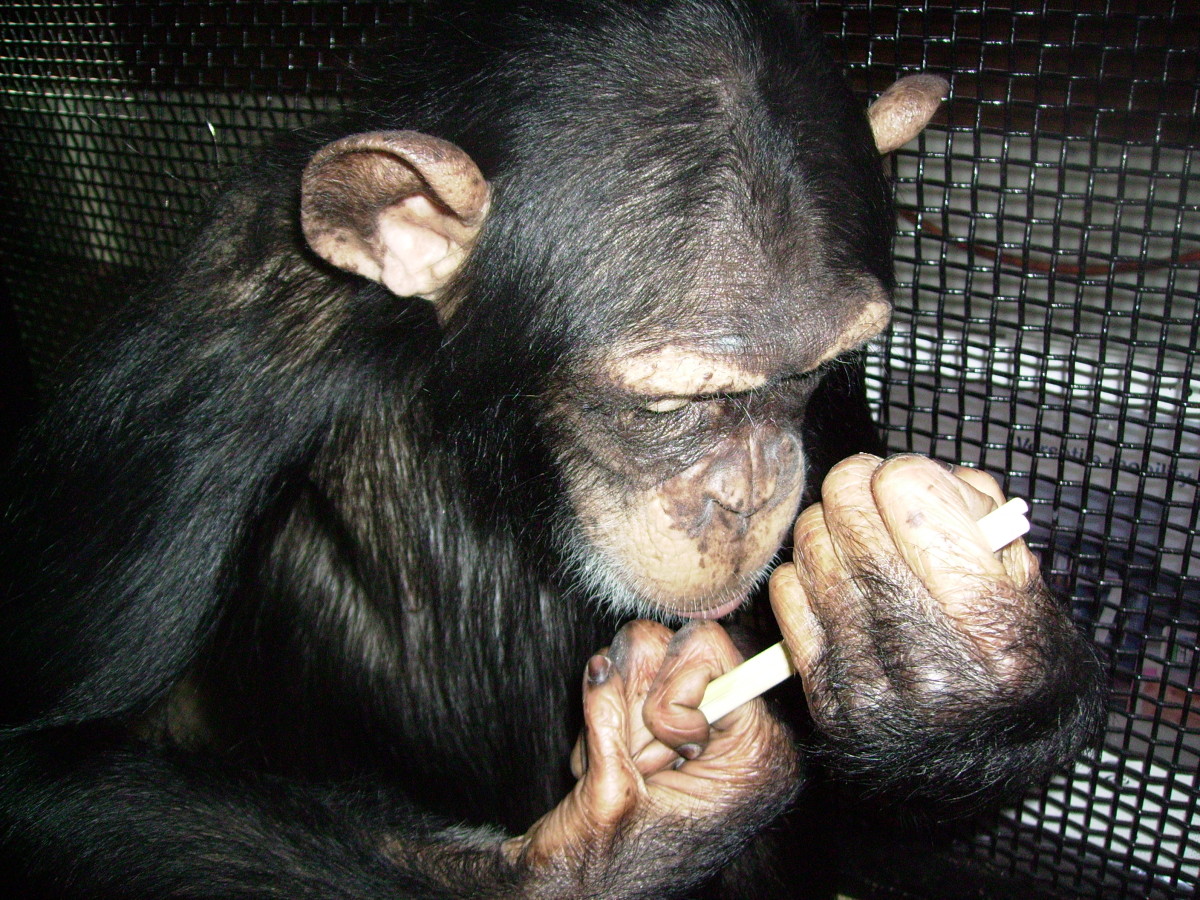A Progress Report in Ape Language Studies: Of Touchscreens and Chopsticks
If you've been following my recent hubs, you might be wondering if I've forgotten I was supposed to be an ape language researcher. What, for instance, does a hub about making money on Hubpages have to do with Project Bow? Or, for that matter, what do Gary Cooper and Patricia Neal have to do with the price of tea in China? Wasn't I supposed to be working on objective proof that Bow can use language?
Everything in life is interconnected, and if you want to know what making money on Hubpages has to do with Project Bow, the answer is quite simple: funding.
Some people think that we should keep funding and research totally separate, in neat little boxes, and never mention one in the same breath as the other. But the fact is that the kind of funding we have affects the kind of research we do -- and not always in the way that most people expect!
We have all kinds of funding at Project Bow, but they are all private donations and non-institutional. People donate their time. People donate equipment. People donate their skills. People even occasionally give money. My job is to see to it that we make the best possible use of these resources, because there is no guarantee that any further donations are forthcoming. What we have, we are very grateful for. But we have to make it last a long, long time!
How is this different from the kind of funding most established scientists have? My funding motivates me to save money. Their funding motivates them to spend it. Here's how it works: a scientist will write a grant application. If a grant is awarded, then the amount of money that the scientist actually gets for his project is contingent on his spending it! It's use it or lose it!
This means that established scientists must go out of their way to buy expensive equipment, hire helpers and spend all left-over money within a certain period of time. If they are later not able to secure more funding, their project has to close down. They have very little control over planning for the future. They are encouraged to be spendthrifts.
In my case, as long as I can keep us fed, we can keep going! We don't have to get new funding all the time, but we do have to stay solvent. This means I have to find creative ways to spend less and achieve more.
A Hypercam view of the RapidQ IDE and Bow's Keyboard in Development
How to Use a Touchscreen for Ape Language Research
We had two touchscreen computers donated to us this year. One was a giant hulk of a thing, which had been used by a liquor company as a way to advertize its products in a bar. Because the patrons could be rowdy, the screen was supposed to be hardened. However, the protective outer skin was already a little cracked when we got it. If a drunken human could do that, what's to prevent a chimpanzee from finishing the job? Chimpanzees are much stronger than humans, and they can be ten times as rowdy, even when sober! I was concerned, but it never really came to anything, since the computer has no operating system, and I don't know how to install one.
The second touchscreen was practically new and was intended as a kitchen computer that people could use to look up online recipes and the like when their hands are covered with flour. It can take a little dirt and water and some abuse. However, it is not up to the sort of treatment that Bow would have given it, if he had direct, unsupervised access.
Two problems had to be solved before we could let Bow use the computer. We had to install it safely, and we had to have appropriate software running. An English language keyboard program was written for me, but I was expected to be able to make modifications as necessary.
For the longest time, I made no headway with that, because every time I tried to make even a minor modification, the source would not compile. Eventually it turned out that I needed to have a library file in the same directory as the compiler. After that, things got a little easier. (The embedded video of the RapidQ IDE was filmed using hypercam2 -- something that my ten year old daughter taught me how to do!)
Sketch made by Lawrence for pen modification

How to Install the Computer without Destroying the Pen
Installing the computer without making any modifications to the pen was an issue that I grappled with for months. The pens have been fashioned from scrap metal and concrete. I built the system of enclosures as cheaply as I possibly could, and it serves us well. The walls are made of an iron grid that had originally been used in a rock quary to sift falling stones. It is very strong, although it was rusty when purchased as salvage.
There is one large piece of glass dividing two of the pens. It is what is called zoo glass and was made to order. The glass is the most expensive component of the system. I don't want to ever buy another piece of zoo glass again. The supplier is used to dealing with institutional purchasers, not individuals, and doing business with such people is really hard for me. They want you to send them a purchase order, and then they have to check your credit rating, even though you are willing to pay them cash up front. They take months to send you the bill, and when you do pay them, they have trouble letting their accounting people know that the bill has been paid, so they call to bother you at home while you have a chimpanzee riding on your back and no pen to put him in. They expect you then and there to check your bank statements, while your chimp is whining that he wants to chew up the furniture!
They have a billing department that is totally separate from their accounting department, and their manufacturing department is separate from shipping, and they ship things without letting you know they are arriving, so that you can't even arrange in advance to have the necessary forklift in order to unload the shipment from the truck. After months of waiting for the zoo glass to arrive, and after you have given up all hope and believe that your order has been completely forgotten, somebody just unexpectedly calls you at six a.m. and says the truck will be there in thirty minutes!
So, no, I'm not making any modifications to the zoo glass! Thank you very much!
What about the iron grid? Could we make a hole big enough for the computer and then use plexiglass to reinforce the screen? I thought about it for a long time, but it seemed so risky! My current handyman, Lawrence, has no experience with welding. He is willing to learn, but I was afraid that whatever we did would end up jeopardizing the structural integrity of the pen.
For a while, we considered installing the computer in a transfer slot that is currently padlocked and was intended to allow interns to give Bow objects without actually going in with him. But the computer is too tall to fit in that slot. Lawrence drew some sketches of how we could install the computer in a metal box with the back of the computer abutting on the transfer slot. The idea was just so we could run the electrical wiring from the pen opposite the one Bow was in.
But I didn't like the idea of having the metal box jutting out from the wall, taking up valuable floor space and creating a safety hazard. "You keep changing your mind," Lawrence told me, as each plan he drew up ended up getting scrapped at the eleventh hour.
"I know," I said.
Lunch

Bow examines a packet of bamboo chopsticks

Inspiration from Lunch
There was another problem that was bugging me, besides the structural integrity of the pen and besides the hazards of tripping over the computer box while playing chase. As I mentioned in the previous hub on the touchscreen, we don't want Bow to be able to touch more than one spot on the screen at a time. The touchscreen is operated on by pressure. It is a resistive touchscreen, made of two flexible sheets and a gap of air between them. When we touch one spot on the screen, contact is made between the two sheets, and this contact is measured in terms of electrical resistance. If we touch two different locations on the screen at the same time, we end up selecting a spot somewhere in the middle. We don't want Bow to be able to do that. We want him to select one letter at a time by pointing at it. Otherwise, we don't get the proof we need.
We also don't want Bow closing and opening windows, reprogramming the computer or playing with volume or contrast. Originally, we intended to solve this problem by having holes drilled in the plexiglass to correspond with locations in the keyboard program. But if we have twenty-six holes in the plexiglass, this does not necessarily prevent Bow from trying to select more than one key at a time and getting confused about which key got selected.
Bow has ten fingers and ten toes and one other extremity that comes standard on males, and he is very limber, so it is quite probable that he will try to stick as many of them as possible into any hole available at the same time!
And besides, would the plexiglass be strong enough, after we drilled holes in it, to resist Bow's attempts to break it? I accidentally dropped a piece of plexiglass on the concrete the other day, and it broke into several pieces. Couldn't Bow, just by sticking his fingers in, make the plexiglass crack and then break? I think he could.
So, one day last week, when Bow and I were having lunch, an idea occurred to me. Instead of drilling holes in the plexiglass, couldn't we use the holes in the grill? I put the touchscreen up to the grill, but the holes were too small for my fingers or Bow's to go through. I happened to have chopsticks handy, and lo and behold, inspirations struck.
We could use a chopstick as a stylus or pointer. The computer would sit safely behind the grid, and Bow could only select one key at a time, because we would only give him one chopstick!
Bow holds a pair of chopsticks

Bow experiments in using a chopstick as a stylus on his touchscreen
Ornate Stylus

The Many and Varied Uses of Chopsticks
The video you see above was filmed last Friday. Bow immediately knew what to do with the chopstick, the moment I gave it to him. However, he was much more interested in selecting the browser behind the keyboard program, because he wanted to watch a video of a basketball game.
Like me, Bow is perfectly aware that there is more than one possible use for a chopstick. He knows it can be used to eat Chinese food. He knows it can be used to select something onscreen. But he is always wiling to experiment further. So that Friday he also tried to use it to pick the lock, to scratch various parts of his body, to self-stimulate and ... if I hadn't taken it away he might have tried to impale himself.
Bow can't be left alone with a computer. But he also can't be left alone with a chopstick. That's okay, though, because we don't leave him alone. I am pretty sure that in time we will be able to impress on him proper chopstick etiquette.
Things Yet To Be Done
We still need the plexiglass. Only now the plexiglass will not serve as a flimsy safety shield. It will merely prevent Bow from closing the window of the keyboard program, resetting or reprogramming the computer or watching YouTube sports videos instead of talking. However, he will be free to tell us if he wants to watch something on YouTube, by spelling it out on his keyboard.
This is an inexpensive, uncomplicated solution I would probably never have thought of, if I had institutional funding. That is why I believe that how we get our funding helps to shape the kind of science we do. It is also why my libertarian outlook is very much a part of the experimental design I have chosen.
Chopsticks you can order online
Some people think that scientists only formulate hypotheses and scientific technicians test them out and politicians decide which hypotheses need to be tested. Here at Project Bow, I wear all the hats. I serve lunch, I clear away the dishes, I clean up messes and enforce potty rules. I play with Bow and I talk to him. I listen to what he has to say. There is not a hub I have written that he hasn't commented on. He knows about our funding problems, and I encourage him to help me in trying to solve them. I also write novels and poems and lyrics for musicals. It's all in a day's work. That's why I consider myself a renaissance person, like the ones Jerilee wrote about in her hub.
You can be a renaissance person, too! If you would like to recreate this experiment at home, just get some chopsticks and a touchscreen and a RapidQ development environment, and see how well your chimp does spelling out words!
(c) 2009 Aya Katz

Touchscreens you can order online
Related Hubs
- Renaissance Scientists - Part I
Ever questioning minds is something that is gifted at birth to just about every child. Yet, somehow in most cases, we manage to thwart this natural tendency in our children. As a mother and grandmother, this fact is one that I think about a lot. - How To Optimize Windows 7 Settings for TouchScreen
A big problem when using a touchscreen is that things are too small to easily click on them. Out of the box Windows 7 is very user freindly, however, these small tweeks can greatly improve your touchscreen... - Being a research mathematician
I am a research mathematician. In my case that means I am employed by the math department of a major university. (All right, sort of a major university.) But being a research mathematician just means that... - What do Scientists do?
Who are the scientists - what do scientists do - what is science anyway? Where does technology fit in? - Eating With Chopsticks
Once you know how to hold chopsticks, you can easily learn to eat with them! Read about chopstick etiquette and try folding your own chopstick rest.










